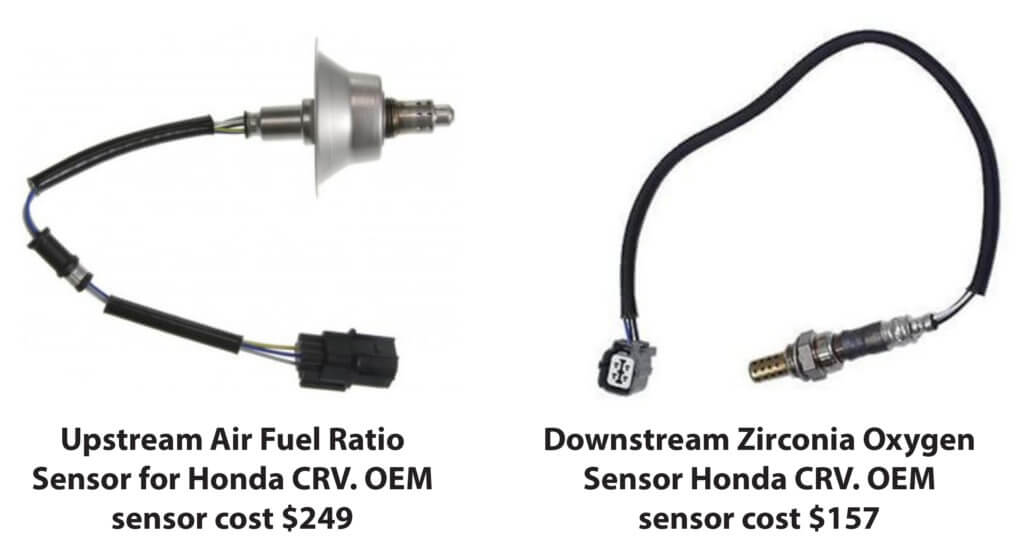Oxygen sensor and air fuel ratio sensor — The differences
Learn the difference between an oxygen sensor and an Air fuel ratio sensor
An oxygen sensor (O2) and an air fuel ratio sensor (AFR) are both used to monitor the exhaust gases of a vehicle and communicate this data to the vehicle’s ECM to optimize the fuel and air mixture coming into the engine’s combustion chamber. However, they arrive at their findings using different methods
How an oxygen sensor works
A traditional narrow-band O2 sensor contains a zirconia/ceramic “thimble” contained in a stainless-steel shell. The inner and outer surfaces of the thimble are coated with a porous platinum electrode. One side of the zirconia thimble is exposed to exhaust gases, while the other side is exposed to atmospheric oxygen, which is actually delivered to the thimble through the sensor wire itself. As oxygen passes through the electrodes, it produces a small voltage that varies based on the difference in oxygen between the exhaust and the air inside the thimble.
The sensor also contains a heater to bring it to about 600°F, where it can begin to produce a small voltage based on the amount of oxygen in the exhaust compared to oxygen in the air.
The midpoint between high and low oxygen content is 450 mV, which signifies the cylinder was provided with a “perfect” 14.7:1 air/fuel ratio. When it senses low oxygen content, the voltage drops to around 200mV. That’s referred to as a “lean exhaust” because the combustion event had too little fuel and finished combustion early, leaving leftover oxygen. When the sensor reports a voltage around 800mV-900mV, it’s referred to as a rich exhaust because there was too much fuel in the combustion event. So, all the oxygen got used up.
The oxygen in the exhaust stream comes in pulses as each cylinder fires, so the O2 sensor provides a rapidly switching voltage over and under 450mV.
Wideband air fuel ratio sensor operation
An AFR works the opposite of a zirconia sensor; its output INCREASES as the exhaust gets leaner. It can even read an extremely lean 18:1 ratio.
Rather than working like a battery that generates voltage changes, an AFR sensor requires a power source. The amount of power varies with each carmaker. Toyota, for example, supplies 3.3 volts to the AFR electronics. The internal circuitry converts the power into a voltage that has a neutral bias. In other words, the voltage can move in a positive or negative flow depending on what the sensor detects.
The bias (no voltage flow) happens when the sensor detects a stoichiometeric/lambda air/fuel mixture of 14.7:1. In other words, when the AFR sees lambda there’s no current flow to the ECM. As the mixture moves toward lean, the signal moves in the positive direction. When it detects a rich condition, voltage flow switches to a negative flow. The flow not only reverses but also changes in amplitude. So, the signal the ECM sees is a linear progression instead of a switching high/low voltage signal.
Key Differences
An air fuel ratio sensor is far more accurate, heats up faster, and responds faster to changes in exhaust oxygen than a narrow band O2 sensor.
While zirconia oxygen sensors have a typical lifespan of only 80,000 to 100,000 miles, AFR sensors are designed to last up to 150,000 miles.
The faster reaction time of the AFR sesnsor allows the carmakers to use thinner coatings of precious metals in the catalytic converter because they won’t have to burn off as much fuel or store as much oxygen as engines outfitted with a conventional oxygen sensor.
Where are air fuel ratio sensors used?
Due to their higher costs, AFR sensors are used as upstream sensors (before the catalytic converter) so the ECM can have more data to improve performance and fuel economy. Since the downstream sensor only measures catalyst efficiency, carmakers can use the less expensive zirconia sensors for that application.

©, 2021 Rick Muscoplat
Posted on by Rick Muscoplat